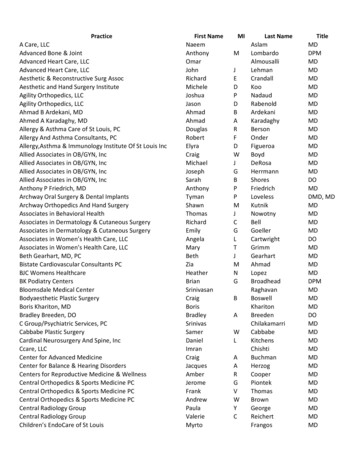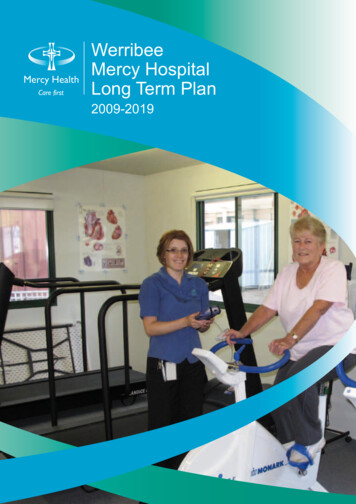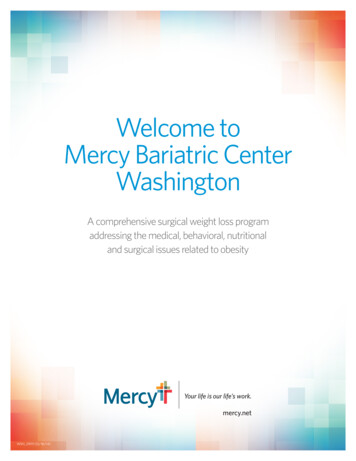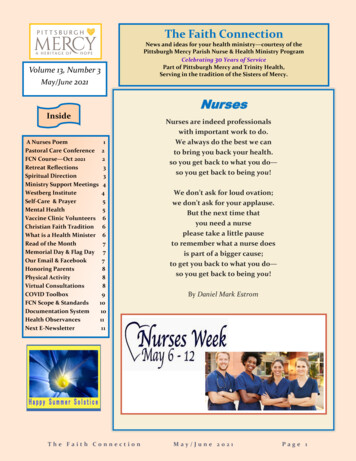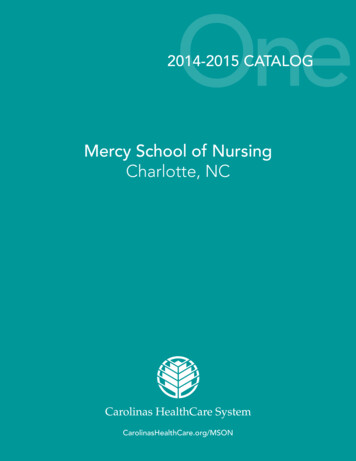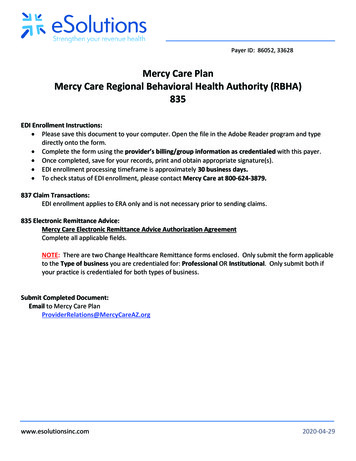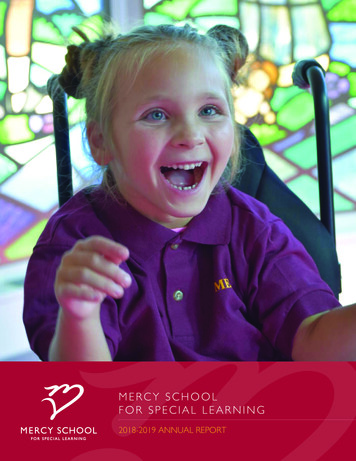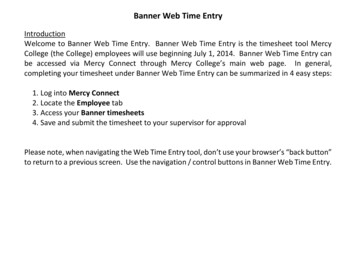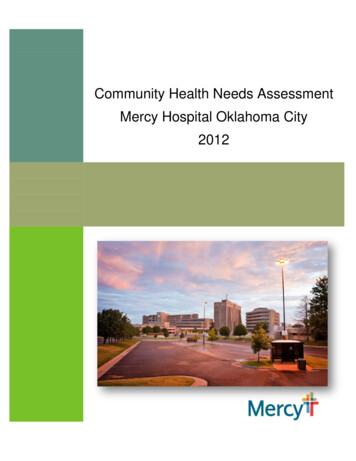
Transcription
Community Health Needs AssessmentMercy Hospital Oklahoma City2012
IntroductionMercy Hospital, Oklahoma City is a hospital with 381 licensed beds and serves a six countyarea. In 2011, the second round of community round tables was conducted to dialogue withcommunity members and public health experts. Mercy Planning and Research providedanalysis of both internal and external demographics, utilization, chronic conditions and healthstatus.The needs assessment process involved review of both quantitative and qualitative informationto attain the full scope of our community’s needs. This summary is documentation that MercyHospital, Oklahoma City is in compliance with IRS requirements for conducting communityhealth needs assessments.Description of CommunityThe service area of Mercy Hospital, Oklahoma City is comprised of six counties (Oklahoma,Canadian, Cleveland, Kingfisher, Lincoln, and Logan) with a population of 1.4 million. The maincampus includes the hospital and five medical buildings. The hospital is a full-service tertiaryhospital with 381 licensed beds, 3,000 co-workers and 24 primary care clinic locations. MercyClinic is a physician-governed group practice comprised of more than 85 board-certified andboard-eligible primary care physicians serving the MHC area. This provider partnership givespatients access to the best quality care in the country with access to an entire health care teamand advanced services. Mercy Clinic physicians also have access to an electronic health recordthat is shared at Mercy facilities in four states, and patients may connect to their own healthrecord and health teams anywhere they connect to the internet through MyMercy.Oklahoma faces a health crisis – 14% of the state population is uninsured. In Oklahoma County,the uninsured represent 21.6% or 1 in 5 people. The majority of these individuals, age 19-64,are working, but their employment does not include health insurance. Being uninsured is a hugebarrier to accessing the health services needed to be healthy. Lack of access to quality healthcare impacts more than the uninsured individual – it impacts families, employers, and thecommunity. Mercy is a strong partner in the Health Alliance for the Uninsured (HAU), which wasformed to improve access to health care for the uninsured. Mercy provides a full time RN,Chronic Disease Management coordinator which works with the 17 free clinics in the greatermetro area. The vice president of Mission/Ethics serves on the HAU Board of Directors andholds the position of treasurer.The president of Mercy Health Center currently serves on the Tobacco Settlement EndowmentTrust (TSET) which funds initiatives that address health/ wellness improvements acrossOklahoma.Staff of the Community Outreach department serve and participate in the Wellness Nowprogram from City/Co. Health Department and Oklahoma Turning Point.Who was involved in AssessmentCitizens of the community were central in the development of this needs assessment. In April of2010 and again in July of 2011, Mercy held community roundtable events to dialogue directlywith local community members about their needs, ideas, and concerns related to healthcare.Common themes included: being involved in the schools to promote and educate onhealth/wellness, access to health care services for all, obesity and the health risks associatedwith tobacco and its related problems, and diabetes. A focus on partnerships, education, andtechnology were listed as ways to improve health/wellness in the community.Summer 2012Page 1
Mercy Planning and Research provided analysis of internal and external demographics, healthresource utilization, chronic conditions and community health status. The consulting group, Sg2was engaged by Mercy as a partner to analyze current utilization and future demand for healthcare services. Contracted patient satisfaction services assist Mercy on an on-going basis bymeasuring and providing benchmark data on patient satisfaction on in-patients, ambulatorysurgery, and emergency room patients.Mercy Community Outreach co-workers collaborate with community partners for ongoingassessment of the needs in the community. Community collaborative partners include:Oklahoma State Department of Health, Oklahoma City/ County Health Department, WellnessNow Initiative, and Oklahoma Turning Point.How the Assessment was ConductedOur needs assessment involved the following five steps to attain the full scope of ourcommunity’s needs.1. Examining existing community health needs assessments.Oklahoma Health Improvement Plan (OHIP)This is a comprehensive plan to improve the health of all Oklahomans developedby the Oklahoma State Board of Health, 2010-2014.Wellness Now Community Health Assessment, 2011 Oklahoma City and CountyThis assessment was completed by the Oklahoma City-County HealthDepartment’s Data Analysis Section in 2010. This nine-month process includes aCommunity Health Status Assessment, a Community Strengths and ThemesAssessment, and a Local Public Health Systems Assessment.Wellness Now-2011-2012 Oklahoma City/CountyThis community health improvement initiative addresses school health, obesity,tobacco use prevention, senior health, mental health, and obstacles to health. Itis designed to pool community resources and expand partnerships to targetedareas with the most needs as a united force and achieve real results.Data from Mercy’s Health Information Systems DepartmentData from Mercy’s own records was pulled and used to assess the needs of thecommunity.2011 State of the State Health ReportThis report that reviews multiple indicators that contribute to Oklahoma’s overallhealth status. It summarizes Oklahoma health as a whole and identifies countyspecific trends.Oklahoma Turning PointTurning Point starts at the local level, building broad community support andparticipation in public health priority setting and action, engaging and linkingaffected people at the local level. Local field consultants in each county ofOklahoma provide leadership in assessing local public health needs andidentifying key priorities.2. Conduct roundtable discussions with community membersCommunity individuals as well as experts in the public health arena were invited toattend community roundtables for input on the needs of the community.Summer 2012Page 2
3. Analyze and summarize the data to prioritize needs.4. Review community benefit activities.5. Create an action plan in partnership with the community.Health Needs IdentifiedAnalyze and summarize the data to prioritize needs (Step 3).The analysis of the combined data collected revealed the following health needs: Diabetes,Obesity, Tobacco Prevention, Cardiac, School health, Access to care.Community Assets IdentifiedThe assessment identified a number of strong community assets which includes the hospitaland its community benefit program, cardiac facility in close proximity, state and city/co. healthdepartments dedicated to identifying, planning, and implementing programs to improve publichealth, school systems (public/private) that strive to increase fitness activities and nutritiousmeals, and the community-based initiative, Turning Point, that aims to transform and strengthenthe public health system through community-based action, and the Health Alliance for theUninsured.Summaries: Assessments and PrioritiesTo set priorities, criteria focused on identifying disproportionate unmet needs, primaryprevention strategies, advancements toward a continuum of care and a program that iscollaborative and involves the community. This is reflective of the heritage of Mercy. Thefollowing priorities are: Diabetes, Access to Care, School Health, Respiratory Diseases, andWellness.Next StepsReview community benefit activities (step 4).Using Lyon Software’s CBISA tool, a review will be conducted of current community benefitactivities and what Mercy was presently doing to meet the identified priorities. In addition, thecommunity benefit activity of other in the community will be reviewed.Create an action plan (step 5).Ongoing and new collaborations with community organizations will address ways identifiedneeds in the community.Summer 2012Page 3
Mercy Hospital, Oklahoma CityCommunity Health Implementation PlanFor FY2012 - 2014Executive SummaryBackground:Mercy Hospital, Oklahoma City is a hospital with 381 licensed beds and serves a six county area. In2011, the second round of community round tables was conducted to dialogue with communitymembers and public health experts. Mercy Planning and Research provided analysis of both internaland external demographics, utilization, chronic conditions, and health status. The needs assessmentprocess involved review of both quantitative and qualitative information to attain the full scope ofour community’s needs.This report summarizes the plan for Mercy Hospital, Oklahoma City to address the identified needsfrom the FY12 Community Health Needs Assessment and sustain existing as well as develop newprograms that respond to these needs.Target Areas and PopulationsThe target area is the service area of Mercy Hospital, Oklahoma City. It is comprised of sixcounties (Oklahoma, Canadian, Cleveland, Kingfisher, Lincoln, and Logan) with apopulation of 1.4 million. The main campus includes the hospital and five medical buildings.The hospital is a full-service tertiary hospital with 381 licensed beds, 3,000 co-workers and24 primary care clinic locations. Mercy Clinic is a physician-governed group practicecomprised of 85 board-certified and board-eligible primary care physicians serving theMercy area. This provider partnership offers access to a comprehensive health care teamand advanced services. Mercy Clinic physicians have access to an electronic health recordthat is shared at Mercy facilities in four states, and patients may connect to their ownhealth record and health teams anywhere they connect to the internet through MyMercy.Oklahoma faces a health crisis – 14% of the state population is uninsured. In OklahomaCounty, the uninsured represent 21.6% or 1 in 5 people. The majority of these individuals,age 19-64, are working, but their employment does not include health insurance. Beinguninsured is a huge barrier to accessing the health services needed to be healthy. Lack ofaccess to quality health care impacts more than the uninsured individual – it impactsfamilies, employers, and the community.How the Community Health Implementation Plan Was DevelopedThe plan was developed based on identified needs and available resources:Mercy Hospital, Oklahoma City FY12 Community Needs AssessmentLocal community agencies/partners who serve those in needMercy Community Outreach Department staffMercy Hospital, Oklahoma City community benefit task forceSummer 2012Page 4
The Oklahoma Community Health Committee is charged with identifying community health needs andcoordinating community health initiatives with the Community Master Plan and service line strategies.The committee provides guidance and direction for implementation strategy.Committee Members include:Aaron Steffens, AdministrationMarilyn Geiger, PhilanthropyPat Robertson, FinanceJaime Hargus, Wellness CoordinatorRichard Barker, Rural HospitalsTom Edelstein, MissionKathryn Abbey, MissionDerek Mountford, Mercy ClinicKristina Dover, MARCOMMGaylene Stiles, Community MinistryDiana Scherber, Mercy PhysiciansDiana Love, FinanceMajor Needs and How Priorities Were EstablishedAfter reviewing the FY12 Community Needs Assessment, five issues were identified as priorities:1. Diabetes2. Access to health care uninsured and underinsured as well as insured3. School Health4. Respiratory diseases5. WellnessQuestionnaires at community events/programs along with current reports from local healthdepartments, confirm these identified priorities. A review of current community benefit programsfound the hospital is also meeting existing community needs through the provision of charity care andMedicaid services.Description of what Mercy Hospital, Oklahoma City will do to address community needsAction Plans:1. Diabetes: Diabetes Wellness Project, Diabetes Treatment and Prevention Program, Mercy ClinicDiabetesThe Diabetes Wellness Project addresses the needs of the uninsured, economically poor prediabetics and diabetic clients. This multi-session program provides diabetes management skills,foot care resources, healthy food selection/preparation, fitness activities, and gratitudejournaling. Project design attends to the mind, body, and spirit of each individual, whichcontributes to improved health and quality of life. Sessions are held at free/charitable clinics atno cost to the client.Summer 2012Page 5
Mercy hospitals in the identified service area will receive a modified version of DiabetesWellness Project. This will be offered in a format that can be individualized to meet the needsof each community.Mercy Hospital Diabetes Treatment and Prevention Program: This program offers educationand support for in-patient and out-patient diabetics that are newly diagnosed of having difficultycontrolling the disease in a group setting or individual appointments.Mercy Clinic is recruiting physicians with a specialty in diabetes.2. Access to care: Health Alliance for the Uninsured (HAU), Project Early Detection , Mercy ClinicBreast CancerThe Health Alliance for the Uninsured is a catalyst for improved health care services for thosewho otherwise would be unable to obtain them. Mercy Hospital, Oklahoma City supports theseefforts by assigning a Chronic Disease Management Coordinator as a resource for the free clinicsand their patients. The vice president of Mission/Ethics serves on the HAU Board of Directorsand holds the position of treasurer. HAU and Mercy collaborations include Super Saturdays forWomen which provides specialized women’s health services. This service meets a critical needfor low-income uninsured women. The Cooperative Central Pharmacy which provides free onsite prescriptions to the uninsured as well as medications to partner charitable clinics is anotherpartnership.Mercy serves the uninsured or underinsured women in need of breast health services throughProject Early Detection. This includes breast health education, screenings, diagnosticprocedures and appropriate treatment referrals. Community partners include social servicesagencies and local non-profits who serve the poor and uninsured. Mercy hospitals in theidentified service area will be able to access Project Early Detection services.Mercy Clinic physicians provide breast cancer services for economically challenged clients.3. School Health: Health Teacher, Linwood Project, Mercy In Schools, Good Shepherd School atMercy, Project SEARCH.Health Teacher is a comprehensive K-12 curriculum that integrates health skills into onlinelesson plans. To date, there are 92 Oklahoma City area school districts with 488 schools thathave signed the letter of participation.Linwood Project is a partnership with an inner-city low-income elementary school. This includesMercy Mentors, a tutoring program that allows Mercy co-workers to travel to the school andtutor during work hours. An annual neighborhood health fair is held for the parents andstudents as well as on-going support/ referral for those in need of specialty health services.Staff of the Community Outreach department serves on the Smart Start Community Councilwhich strives to prepare young children to attend school.Mercy in Schools works with school districts to tailor a model which best serves the community.This partnership increases access to medical services, provides health education, and improvesSummer 2012Page 6
the mental well-being of students and staff. Components of Mercy In Schools includes: Call Sam,Access to medical services through the UCO campus clinic, Physician Support, and Mentorshipsin Medicine.Good Shepherd Catholic School at Mercy is a partnership between Mercy, University of CentralOklahoma, and the Archdiocese of OKC. It is focused on serving children with autistic spectrumand similar neurological disorders. Students aged 3-9 receive individual behavioral training andeducation. The school has a capacity of 22 students with current enrollment of 9 students.Project SEARCH, a collaboration of Francis Tuttle Career Technology Center and Mercy, receivesfree office and classroom space. This program strives to prepare developmentally challengedyoung adults for career opportunities. Students rotate through a variety of departments atMercy Hospital.4. Respiratory Diseases: Tobacco Prevention, Better Breathers, Mercy Clinic respiratoryThe Better Breathers Support group meets monthly with an educational program and luncheonfor people in the community who have chronic respiratory conditions.Tobacco Prevention will be addressed through the Tobacco Cessation Initiative for OklahomaHospitals. The program services will include assessing and assisting the adoption andimplementation of a sustainable system for patients and co-workers for tobacco cessation. Thiswill be channeled through the Healthification process at Mercy which is an internal employeewellness program. Mercy Hospital, Oklahoma City is a smoke-free facility and campus. Thepresident of Mercy Hospital, Oklahoma City currently serves on the Tobacco SettlementEndowment Trust (TSET) which funds initiatives that address health/ wellness improvementsacross Oklahoma.Respiratory diseases will be addressed in the quarterly OUTREACH newsletter with opportunityfor the community to request free publications.Mercy Clinic, has recruited several pulmonologists.5. Wellness: Healthification, Diabetes Wellness Project, Health Teacher, “Battling the Silent Killer”,multiple services/resources for the community at large and across the Mercy West Region.Obesity is integrated and addressed through the Diabetes Wellness Project, Health Teacher, andHealthification programs. Healthification is the pursuit of personal well-being for Mercy coworkers and their families. It focuses on healthy eating, physical activity, emotional and spiritualwell-being, and tobacco cessation.“Battling the Silent Killer” is an initiative which includes a fresh look at the importance of bloodpressure and its role in stroke, heart, and kidney disease prevention. This program will beoffered to each Mercy hospital in Oklahoma.Flu shots, quarterly OUTREACH newsletter, caregiving issues. Elder Law Day, CaregiverConference.Summer 2012Page 7
Needs not being addressed and the reasonsMercy Hospital, Oklahoma City is not directly involved with Cardiac issues due to the close proximity andpartnership with the Oklahoma Heart Hospital.ApprovalThe Mercy Hospital, Oklahoma City Governing Board, which includes representatives from thesurrounding community, reviews the prior fiscal year’s Community Benefit Report and approves theCommunity Health Implementation Plan for addressing priorities identified in the most recentCommunity Assessment and other plans for community benefit.Summer 2012Page 8
Oklahoma CityCommunity Health NeedsAssessment – Supporting Data
Oklahoma City, OK (6-County PSA)DemographicsDEMOGRAPHIC CHARACTERISTICSSelectedArea2000 Total Population1,036,4912011 Total Population1,191,0682016 Total Population1,250,099% Change 2011 - 20165.0%Average Household Incom e 59,116USA281,421,906310,650,750323,031,6184.0% 67,529Total Male PopulationTotal Fem ale PopulationFem ales, Child Bearing Age (15-44)POPULATION ,535312,255147,328126,02542,8351,250,099Incom e 100.0%USA ATION LEVEL2011 Household Incom e 15K 15-25K 25-50K 50-75K 75-100KOver 100KTotalHH .2%29.4%19.6%10.9%13.8%USA .0%RACE/ETHNICITYEducation Level Distribution2011 Adult Education LevelLess than High SchoolSom e High SchoolHigh School DegreeSom e College/Assoc. DegreeBachelor's Degree or GreaterTotal2016% Change615,1335.0%634,9664.9%250,7801.0%HOUSEHOLD INCOME DISTRIBUTIONAge DistributionAge Group0-1415-1718-2425-3435-5455-6465-7980 Total2011585,566605,502248,230Pop Age 25 7.6%31.8%27.7%100.0%USA 20116.3%8.8%28.9%28.3%27.7%100.0%Race/Ethnicity DistributionRace/EthnicityWhite Non-HispanicBlack Non-HispanicHispanicAsian & Pacific Is. Non-HispanicAll OthersTotal2011 %11.1%11.0%3.1%6.5%100.0%USA 201164.2%12.1%16.1%4.6%3.0%100.0%Source: Thomson Reuters, 2011
Oklahoma City, OK (6-County PSA)ED VisitsBelow is a comparison of emergent to urgent visit volume by consumer group in the six-county Oklahoma City Primary Service Area.ED Utilization by Consumer Group: Emergent vs. leAge Group0-1718-4445-6465 0-1718-4445-6465 TOTAL2010Emergent ,699190,0822010Urgent ,978422,097Source: Thomson Reuters Emergency Department Estimates, 20102010Total 1,677612,179In the Oklahoma City PSA, 69% of ED visitsare considered urgent.On a national scale, 68% of ED visits areconsidered urgent and can likely be treatedin different care settings.The majority of urgent ED services inthe Oklahoma City PSA are rendered tofemales, ages 18-44—generating 34%more non-emergent volume in the EDthan the next largest consumer group,males, 0-17.
Oklahoma City, OK (6-County PSA)Top ED Diagnosis CodesDiagnosis3-digit ICD9Volume%*SYMPTOMS INVOLVING RESPIRATORY SYSTEM/CHEST78615,775 8.8%OTHER SYMPTOMS INVOLVING ABDOMEN & PELVIS78915,118 8.4%GENERAL SYMPTOMS78011,388 6.3%ASTHMA4935,199 2.9%SYMPTOMS INVOLVING HEAD & NECK7845,103 2.8%SYMPTOMS INVOLVING DIGESTIVE SYSTEM7874,512 2.5%DISORDERS OF URETHRA & URINARY TRACT NEC5993,799 2.1%INJURY NEC & NOS9593,414 1.9%OTHER & UNSPECIFIED BACK DISORDER7243,246 1.8%BACK SPRAINS & STRAINS NEC & NOS8473,004 1.7%Diagnosis3-digit ICD9Volume%*OTHER DIAGNOSESXXX17,460 3.7%GENERAL SYMPTOMS78014,064 3.0%ACUTE UPPER RESPIRATORY INFECTION MULT SITES NOS46513,889 3.0%OTHER & UNSPECIFIED BACK DISORDER72413,348 2.9%BACK SPRAINS & STRAINS NEC & NOS84713,282 2.8%SUPPURATIVE/NOS OTITIS MEDIA38212,795 2.7%OTHER SYMPTOMS INVOLVING ABDOMEN & PELVIS78911,758 2.5%OPEN WOUND HEAD NEC87311,348 2.4%ACUTE PHARYNGITIS46211,278 2.4%OTHER CELLULITIS & ABSCESS68211,202 2.4%Source: Thomson Reuters, Outpatient Health Profiles, 2009
Oklahoma City, OK (6-County PSA)ChronicConditionsIdentified Among18 PopulationDiseasePain/Aching of JointsHypertensionLow Back PainArthritisMigraine HeadachesSinusitisAsthmaDepression/AnxietyHay FeverDiabetesHearing ImpairmentCoronary Heart DiseaseChronic BronchitisHeart AttackStrokeAnginaUlcersCongestive Heart FailureEmphysemaWeak/Failing KidneysBreast CancerLiver ConditionProstate CancerCervical CancerSkin CancerColon/Rectal CancerUterine CancerLung CancerPrevalentCases% of %5,3001%5,1561%4,3220%3,1820%2,0090%Source: Thomson Reuters Continuum of Care, 2011Prevalent Cases 65Count % of Disease evalent Cases 65 Count % of Disease %74514%2,21243%2,89767%1,30441%1,31966%
Oklahoma City, OK (Oklahoma County)ChronicConditionsIdentified Among18 PopulationDiseasePain/Aching of JointsHypertensionLow Back PainArthritisMigraine Hay FeverHearing ImpairmentCoronary Heart DiseaseChronic BronchitisHeart AttackStrokeAnginaUlcersCongestive Heart FailureEmphysemaWeak/Failing KidneysBreast CancerLiver ConditionProstate CancerCervical CancerSkin CancerColon/Rectal CancerUterine CancerLung CancerPrevalentPrevalent Cases 65Cases% of Pop Count % of Disease Cases164,34529% 120,12073%159,75728% 100,32963%148,16426% 118,51780%121,73721% 73,82061%71,93613% 67,66394%70,36712% 56,88181%66,33512% 56,30385%59,02310% 50,31785%45,1498% 27,31861%43,6478% 36,95685%31,5596% 14,74847%23,5434%9,50940%21,8014% %88531%2,0210%1,14557%1,3120%43833%Source: Thomson Reuters Continuum of Care, 2011Prevalent Cases 65 Count % of Disease 415%1,42845%1,94569%87643%87467%
BENTON COUNTY, AROklahoma City, OK (Oklahoma County)HOW IS YOUR GENERAL HEALTH?Health StatusSource: County Health Rankings – Robert Wood Johnson Foundation and University of Wisconsin Population Health Institute, 2011
BENTON COUNTY, AROklahoma City, OK (Oklahoma County)HOW IS YOUR GENERAL HEALTH?Child Health IndicatorsSource: The Annie E. Casey Foundation, Kids Count Data Center; Oklahoma Institute for Child Advocacy
Oklahoma City, OKSayre, OK, Beckham County,121 miles west of Oklahoma CityThe Oklahoma CityPrimary Service Area (PSA) comprisessix counties in central OklahomaMercy LocationsHospitalManaged HospitalClinicUrgent/ Convenient Care
FY10 Top Acute Inpatient DischargesNote: Accounts for 31% of their total 16,126 Acute IP DischargesMSDRG Description/CodeVaginal Delivery W/O Complicating Diagnoses (775)FY10% of TotalInpatient InpatientDischarges DischargesAge Breakouts 18%18-44 % 45-64 % 65-79 %80 %1,4749%302% 1,444 98%00%00%00%Cesarean Section W/O CC/MCC (766)8996%152%10%00%00%Major Joint Replacement Or Reattachment Of Lower Extremity W/O MCC (470)5183%10%Cesarean Section W CC/MCC (765)4723%102%460 97%20%00%00%Neonate W Other Significant Problems (794)3372%337 100%0 0%00%00%00%Esophagitis, Gastroent & Misc Digest Disorders W/O MCC (392)3312%72%71 21%101 31%84 25%Uterine & Adnexa Proc For Non-Malignancy W/O CC/MCC (743)2652%31%139 52%106 40%176%00%Prematurity W/O Major Problems (792)2331%233 100%0 0%00%00%Nutritional & Misc Metabolic Disorders W/O MCC (641)2281%104%23 10%40 18%66 29%89 39%Kidney & Urinary Tract Infections W/O MCC (690)2071%73%189%31 15%51 25%100 48%4,96431%65313% 3,050 61%475 10%TOTALSource: Mercy Discharge Data, FY10883 98%122%194 37%00%229 44%4479%82 16%68 21%3397%
FY10 Top Inpatient Admissions from the EDNote: Accounts for 20% of their total 5,071 ED AdmissionsMSDRG Description/CodeAge BreakoutsFY10% of TotalInpatient ED InpatientDischarges Discharges 18 % 18-44 % 45-64 % 65-79 %80 %Esophagitis, Gastroent & Misc Digest Disorders W/O MCC (392)1773%00%46 26%51 29%48 27%32 18%Kidney & Urinary Tract Infections W/O MCC (690)1252%65%108%17 14%34 27%58 46%Nutritional & Misc Metabolic Disorders W/O MCC (641)1162%43%14 12%17 15%34 29%47 41%Intracranial Hemorrhage Or Cerebral Infarction W CC (065)1112%00%44%17 15%46 41%44 40%Intracranial Hemorrhage Or Cerebral Infarction W MCC (064)872%00%67%12 14%25 29%44 51%Appendectomy W/O Complicated Principal Diag W/O CC/MCC (343852%9 11%60 71%14 16%Transient Ischemia (069)782%00%Poisoning & Toxic Effects Of Drugs W/O MCC (918)741%23%Simple Pneumonia & Pleurisy W CC (194)731%57%Cellulitis W/O MCC (603)741%01,00020%26TOTALSource: Mercy Discharge Data, FY10222%00%3%27 35%30 38%34 46%24 32%12 16%7%17 23%19 26%27 37%0%16 22%33 45%13 18%12 16%3%197 20%229 23%263 26%285 29%519 24%23%
Top ED Visit Volume By ICD9 CodesOctober 1, 2010 - September 30, 2011Note: Accounts for 16% of their total 48,559 ED DischargesICD9Code DiagnosisED% of EDVolume Volume 1818-44Age Breakouts45-6465-79784.0- HEADACHE1,1892%787%73262%28724%599.0- URINARY TRACT INFECTION, SITE NOT %21121%71959.01 - HEAD INJURY, UNSPECIFIED8682%29334%21425%13215%382.9- UNSPECIFIED OTITIS MEDIA7011%60386%12%142%2465.9- ACUTE UPPER RESPIRATORY INFECTIONS OF UNSPECIFIED SITE6021%41068%8213823%386%13787.01 - NAUSEA WITH VOMITING5531%11120%24644%11721%462- ACUTE PHARYNGITIS5511%23042%27650%377%780.2- SYNCOPE AND COLLAPSE5411%458%20137%134490- BRONCHITIS, NOT SPECIFIED AS ACUTE OR CHRONIC5331%13325%24646%967,69816%789.00 - ABDOMINAL PAIN, UNSPECIFIED SITETOTALNote: 1,356 (3%) of ED discharges did not list diagnosisSource: Epic ED Discharges, October 1, 2010 – September 30, 20112,12928% 3,11340% 1,2306580 5%272%213 18%27023%7%273%94 11%13516%0%00%2%30%55 10%244%1%41%25%85 16%7614%18%38204%416% 6407%8%5868%
Oklahoma City, OKFort SmithPotentially Avoidable Admissions by Diagnosis1,400Total: 1,1961,2001,000800AnginaPerforated Appendix153159HypertensionLower Extremity AmputationDiabetes60023024740012796Adult Asthma288COPD2000PAA Detail by Diagnosis GroupCY2009DehydrationUTICHFBacterial PneumoniaPAA potentially avoidable admission; CY calendar year; angina chest pain, chest discomfort; UTI urinary tract infection; COPD chronicobstructive pulmonary disease (eg, bronchitis, emphysema); CHF congestive heart failure. Analysis excludes normal newborns, neonates andpediatrics. Sources: Mercy: Mercy Health Center; Sg2 Analysis, 2010.
PAA slide notesMercy Health CenterOklahoma City Bottom line: The distribution of potentially avoidable admissions at Mercy Health
1. Examining existing community health needs assessments. Oklahoma Health Improvement Plan (OHIP) This is a comprehensive plan to improve the health of all Oklahomans developed by the Oklahoma State Board of Health, 2010-2014. Wellness Now Community Health Assessment, 2011 Oklahoma City and County

